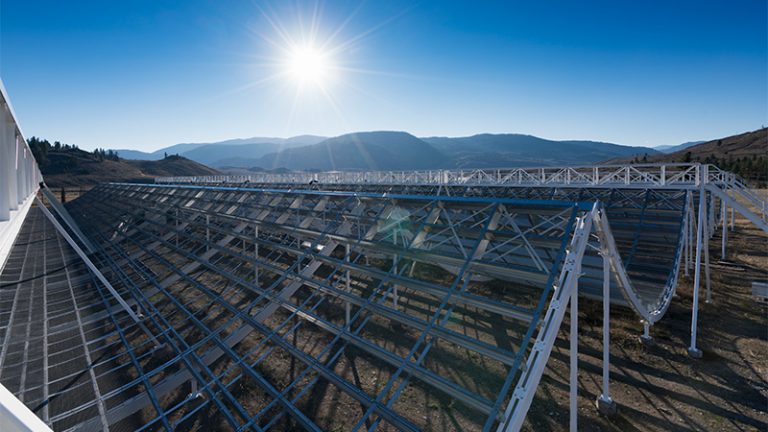Astronomers in the Canadian-led CHIME/FRB Collaboration have doubled the number of known repeating sources of mysterious flashes of radio waves, known as fast radio bursts (FRBs). Among them are astronomers from the University of Toronto. Through the discovery of 25 new repeating sources (for a total of 50), the team has also solidified the idea that all FRBs may eventually repeat.
FRBs are considered one of the biggest mysteries in astronomy, but their exact origins are unknown.
Astronomers do know that they come from far outside of our Milky Way, and are likely produced by the cinders left behind after stars die. Most of the thousands of FRBs that astronomers have discovered to date have only ever been seen to burst once, but there is a small subset that have been seen to burst multiple times. One of the big questions is whether the repeating FRBs and those that don’t repeat have similar origins. One key clue is that the two populations seem to have different characteristics, such as the durations of the bursts they produce, and the range of frequencies emitted. This has led to the consensus that there are possibly two distinct categories of FRBs: repeaters, and one-offs, with different origins.
Finding more repeating sources is key to answering this question and in new research published today in the Astrophysical Journal, the CHIME/FRB Collaboration presents 25 new sources. While they had previously established repeating FRBs as a class of sources, this is the first time they have combed through the data to find every repeating source detected so far, including the less obvious ones. To make this happen, the team developed a new set of statistics tools.

“We can now accurately calculate the probability that two or more bursts coming from similar locations are not just a coincidence,” explains Ziggy Pleunis, a Dunlap Postdoctoral Fellow at the Dunlap Institute for Astronomy & Astrophysics and corresponding author of the publication. “These new tools were essential for this study, and will also be very useful for similar research going forward.”
Thanks to radio telescopes like the Canadian Hydrogen Intensity Mapping Experiment (CHIME), the number of detected FRBs has grown from a few tens, to thousands in recent years. This is due to CHIME’s capacity to scan the entire northern sky every day. “That’s how CHIME has an edge over other telescopes, when it comes to discovering FRBs,” says Pleunis.
In their new research, the CHIME/FRB Collaboration has demonstrated that many repeating FRBs are surprisingly inactive, producing less than one burst per week of observing time.

“Many apparently one-off FRBs have simply not yet been observed long enough for a second burst from the source to be detected,” says Pleunis.
Repeating sources of FRBs are uniquely valuable to astronomers. First, knowing that a source is a repeater creates an opportunity to observe that same source with other telescopes in more detail. And second, more bursts give us more information on the diversity of emission that a source can produce.

“It is exciting that CHIME/FRB saw multiple flashes from the same locations, as this allows for the detailed investigation of their nature,” says Adaeze Ibik, a PhD student in the at the University of Toronto, who has led the search for the galaxies in which some of the newly identified repeating FRBs are embedded, as reported in an accompanying research publication
currently under review. “We were able to hone in on some of these repeating sources and have already identified likely associated galaxies for two of them.”
Pleunis notes that this new discovery brings us closer to understanding what FRBs are. While that is exciting in itself, he says there are even further-reaching implications.
“FRBs are likely produced by the leftovers from explosive stellar deaths.” Pleunis says. “By studying repeating FRB sources in detail, we can study the environments that these explosions occur in and understand better the end stages of a star’s life.”
“We can also learn more about the material that’s being expelled before and during the star’s demise, which is then returned to the galaxies that the FRBs live in.”
The CHIME project is co-led by the University of British Columbia, McGill University, University of Toronto, and the Dominion Radio Astrophysical Observatory with collaborating institutions across North America.

